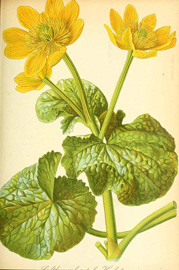Marsh Marigold:
The Other Irish Charm
By Audrey Stallsmith

'And winking Marybuds begin
To ope their golden eyes.'
Cymbeline Act II, Scene 3—William Shakespeare
When driving home from church in spring, our family members have always kept an eye on one particular roadside ditch, looking for the first sign of mounding plants with large yellow blooms. Dad calls them cowslips. But, since I associate that nickname with primroses, I call them marsh marigolds.
Both of us are right since cowslips is one of marsh marigolds’ nicknames, along with cowflocks, kingcups, water blobs, Mayflowers, etc. Growing 1 to 2 feet tall with glossy heart-shaped leaves and equally glossy blooms that look like oversized 1 to 2-inch buttercups, they belong to that plant family.
Depending on the zone in which you live, these marigolds can “ope their golden eyes” as early as mid-March or as late as June. They reportedly watch the sun with those eyes and close when it disappears. Thomas Hardy may have been implying that the sun had gone in when he wrote in “Overlooking the River Stour” that
“Closed were the kingcups; and the mead
Dripped in monotonous green,
Though the day’s morning sheen
Had shown it golden and honey-bee’d.”
Perhaps because they originally were dedicated to the virgin Mary, the golden flowers stand for “divine beauty” in the Language of Flowers. The Irish once gathered those blooms for protection against fairies, witches, and maleficent spirits on May Eve. So marsh marigolds apparently were considered as lucky as those famous shamrocks!
Their scientific designation, Caltha palustris, derives from the Greek calathos (‘goblet”) and palus (“marsh”). As that name indicates, the plants prefer wet conditions.
Even though their raw foliage is toxic enough to poison cows and horses, plucky people used to eat the plants’ leaves as a spring green, boiling off the poison first with several changes of water as weed connoisseurs do for poke also! We can deduce that there were so few greens available in winter back then that everybody wanted to grab the first ones they could get once that barren season had passed.
Although the plants also were used to treat fits, anemia, heart problems, and boils, the juice of their leaves can cause skin irritation. So much so that they sometimes were employed to burn off warts as well. Therefore, you’d probably best admire marsh marigolds from a distance as we do. However, there is one particularly lovely double type called Caltha palustris ‘Flore Pleno’ that you might want to grow in your garden.
After all, following a wearisome winter, nothing quite lifts the spirits as much as seeing those flowers’ sunny flash of life. Tennyson writes in “The May Queen,” that it “shines like fire in swamps and hollows gray.” As George Markham Tweddel concludes in ”The Marsh Marigold,” “The earth is now/Not vile, but fit for angels.”
The Caltha palustris image is from Gartenflora by E. Von Regel, courtesy of plantillustrations.org.








